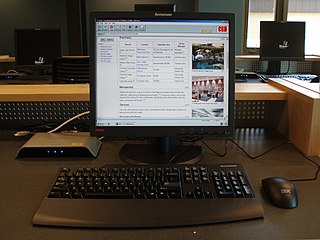
In computer networking, a thin client, sometimes called slim client or lean client, is a simple (low-performance) computer that has been optimized for establishing a remote connection with a server-based computing environment. They are sometimes known as network computers, or in their simplest form as zero clients. The server does most of the work, which can include launching software programs, performing calculations, and storing data. This contrasts with a rich client or a conventional personal computer; the former is also intended for working in a client–server model but has significant local processing power, while the latter aims to perform its function mostly locally.

The X Window System is a windowing system for bitmap displays, common on Unix-like operating systems.

A Beowulf cluster is a computer cluster of what are normally identical, commodity-grade computers networked into a small local area network with libraries and programs installed which allow processing to be shared among them. The result is a high-performance parallel computing cluster from inexpensive personal computer hardware.

CUPS is a modular printing system for Unix-like computer operating systems which allows a computer to act as a print server. A computer running CUPS is a host that can accept print jobs from client computers, process them, and send them to the appropriate printer.

chroot is an operation on Unix and Unix-like operating systems that changes the apparent root directory for the current running process and its children. A program that is run in such a modified environment cannot name files outside the designated directory tree. The term "chroot" may refer to the chroot(2) system call or the chroot(8) wrapper program. The modified environment is called a chroot jail.
9P is a network protocol developed for the Plan 9 from Bell Labs distributed operating system as the means of connecting the components of a Plan 9 system. Files are key objects in Plan 9. They represent windows, network connections, processes, and almost anything else available in the operating system.
Nagios is an event monitoring system that offers monitoring and alerting services for servers, switches, applications and services. It alerts users when things go wrong and alerts them a second time when the problem has been resolved.

ClamAV (antivirus) is a free software, cross-platform antimalware toolkit able to detect many types of malware, including viruses. It was developed for Unix and has third party versions available for AIX, BSD, HP-UX, Linux, macOS, OpenVMS, OSF (Tru64), Solaris and Haiku. As of version 0.97.5, ClamAV builds and runs on Microsoft Windows. Both ClamAV and its updates are made available free of charge. One of its main uses is on mail servers as a server-side email virus scanner.

ifconfig is a system administration utility in Unix-like operating systems for network interface configuration.
NX technology, commonly known as NX or NoMachine, is a remote access and remote control computer software allowing remote desktop access and maintenance of computers. It is developed by the Luxembourg-based company NoMachine S.à r.l. NoMachine is proprietary software and is free-of-charge for non-commercial use.
Remote administration refers to any method of controlling a computer or other Internet-connected device, such as a smartphone, from a remote location. There are many commercially available and free-to-use software that make remote administration easy to set up and use. Remote administration is often used when it's difficult or impractical to be physically near a system in order to use it or troubleshoot it. Many server administrators also use remote administration to control the servers around the world at remote locations. It is also used by companies and corporations to improve overall productivity as well as promote remote work. It may also refer to both legal and illegal remote administration.
A dedicated hosting service, dedicated server, or managed hosting service is a type of Internet hosting in which the client leases an entire server not shared with anyone else. This is more flexible than shared hosting, as organizations have full control over the server(s), including choice of operating system, hardware, etc.

Linux is a family of open-source Unix-like operating systems based on the Linux kernel, an operating system kernel first released on September 17, 1991, by Linus Torvalds. Linux is typically packaged as a Linux distribution (distro), which includes the kernel and supporting system software and libraries—most of which are provided by third parties—to create a complete operating system, designed as a clone of Unix and released under the copyleft GPL license.
A desktop environment is a collection of software designed to give functionality and a certain look and feel to an operating system.
A web desktop or webtop is a desktop environment embedded in a web browser or similar client application. A webtop integrates web applications, web services, client–server applications, application servers, and applications on the local client into a desktop environment using the desktop metaphor. Web desktops provide an environment similar to that of Windows, Mac, or a graphical user interface on Unix and Linux systems. It is a virtual desktop running in a web browser. In a webtop the applications, data, files, configuration, settings, and access privileges reside remotely over the network. Much of the computing takes place remotely. The browser is primarily used for display and input purposes.
A home server is a computing server located in a private computing residence providing services to other devices inside or outside the household through a home network or the Internet. Such services may include file and printer serving, media center serving, home automation control, web serving, web caching, file sharing and synchronization, video surveillance and digital video recorder, calendar and contact sharing and synchronization, account authentication, and backup services. In the recent times, it has become very common to run hundreds of applications as containers, isolated from the host operating system.
This is a comparison of notable free and open-source configuration management software, suitable for tasks like server configuration, orchestration and infrastructure as code typically performed by a system administrator.

Snare is a collection of software tools that collect audit log data from a variety of operating systems and applications to facilitate centralised log analysis. Enterprise Agents are available for Linux, macOS, Windows, Solaris, Microsoft SQL Server, a variety of browsers, and more. Snare Enterprise Epilog for Windows facilitates the central collection and processing of Windows text-based log files such as ISA/IIS. Snare Enterprise Epilog for Unix provides a method to collect any text based log files on the Linux and Solaris operating systems. Opensource Agents are available for Irix and AIX.
Big Brother was a tool for systems and network monitoring, generally used by system administrators. The advent of the dynamic web page allowed Big Brother to be one of the first monitoring systems to use the web as its user interface. Prior to this, monitoring tools were generally console based, or required graphic terminals such as X Window to operate. Big Brother produces HTML pages containing a simple matrix of hosts and tests with red and green dots to denote system status. Big Brother was named after George Orwell's character Big Brother from his novel Nineteen Eighty-Four. E-mail from Big Brother originated from the Ministry of Truth, and users of the software were called Brothers.
The following outline is provided as an overview of and topical guide to the Perl programming language:









